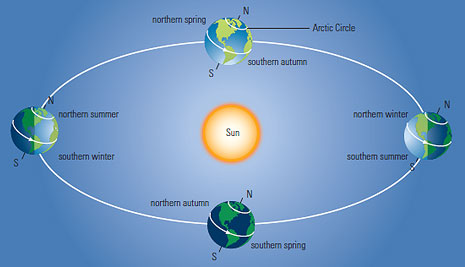Prekinder to Grade 2 Mathematics
The Orbit of the Earth and Hours of Daylight
The Orbit of the Earth and Hours of Daylight

Hi everyone, my name is Blublubox. I am a friendly alien from the planet Blebeep who is visiting the Earth. While I've been on Earth, I've noticed many interesting things. One is that the Sun "rises" and "sets" at different times each day. The days seem to be longer during the summer than they are during the winter as well. I asked my friend Sam if he could help me to understand what was going on.
The Earth Orbits the Sun

orbits the Sun. While the Earth moves around the sun, it is spinning on its own axis. This is what
gives us night and day. Parts of the Earth that face the Sun receive daylight (light from the Sun), and parts of the Earth that face away from the Sun experience night time. It takes \(24\) hours for the Earth to
completely rotate on its axis.
The Earth is Tilted
If the Earth was perfectly vertical (straight up and down) as it spun on its axis, the daytime and nighttime would be the same length all the time. This is not what happens at all!

The Earth is actually on a slant as it rotates around its axis and orbits the Sun. It lies at an angle of \(23.5^\circ\). This means that parts of the Earth are closer to the Sun, and parts of the Earth are further away from the Sun at different times of the year. The parts of the Earth that are closer to the Sun get warmer weather and longer hours of daylight. The parts of the Earth that are further away from the Sun get cooler weather and shorter hours of daylight. This is what causes the seasons on Earth, and it is the reason why we have longer hours of daylight during the summer (warmer) months and shorter hours of daylight during the winter (cooler) months. This also means that the Sun is high in the sky during the summer months and low in the sky during the winter months.
The poles of the Earth are the closest points to the Sun during the summer, and the furthest points away from the Sun during winter. This is why they experience the "Midnight Sun" during the summer months and no sunlight at all during the winter months.
Well that was everything that Sam explained to me. We get seasons and longer and shorter days because the Earth is tilted on its axis. It's just like the way you feel warmer when you are closer to the heater and cooler when you are further away from it. It makes sense, doesn't it?
Description
This mini book covers the core of Math for Foundation, Grade 1 and Grade 2 mathematics including
- Numbers
- Addition
- Subtraction
- Division
- Algebra
- Geometry
- Data
- Estimation
- Probability/Chance
- Measurement
- Time
- Money
- and much more
This material is provided free of cost for Parent looking for some tricks for their Prekinder, Kinder, Prep, Year 1 and Year 2 children
Audience
Grade 1/Year 1, Grade 2/Year 2, Prep, Foundation, Kinder and Pre-Kinder
Learning Objectives
These lessons are for kids aged 4-8 with the core objective to expose their brains to concepts of addition, subtraction, division, algebra and much more.
Author: Subject Coach
Added on: 6th Apr 2018
You must be logged in as Student to ask a Question.
None just yet!